Florida, the Sunshine State, is not only famed for its stunning beaches, diverse wildlife, and vibrant culture but also for its impressive array of artificial lakes. These lakes, created by human ingenuity, enrich Florida’s already abundant natural beauty, adding a unique touch to its varied landscapes.
Artificial lakes in Florida serve multiple purposes. They are crucial for flood control, providing drinking water, irrigation, and generating hydroelectric power. Moreover, they have become significant recreational hubs, attracting locals and tourists alike with a wide array of activities, from fishing to boating and wildlife viewing.
However, these lakes are not just about utility and leisure. They’ve evolved into vibrant ecosystems, providing habitats for a diverse range of flora and fauna. Each lake has its own unique ecological footprint and contributes significantly to Florida’s rich biodiversity.
In this article, we discover the oldest artificial lake in Florida.
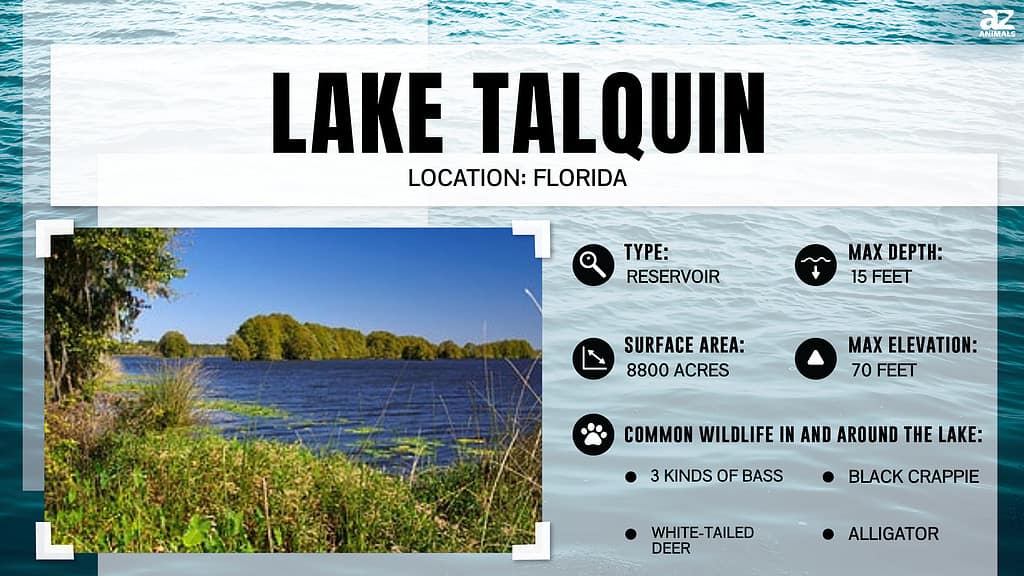
We invite you on a journey exploring the lake’s rich history, the vibrant life it supports, the joy it brings to recreation enthusiasts, and its crucial role in shaping the environment.
The Oldest Artificial Lake in Florida
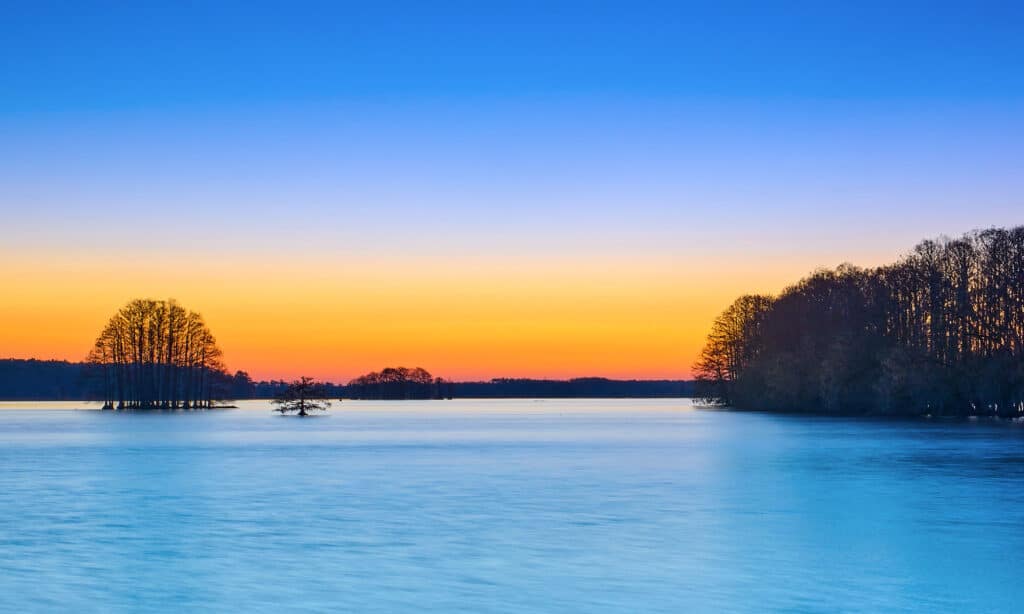
Dusk at Lake Talquin State Park near Tallahassee, FL.
©iStock.com/Patrick Jennings
Constructed between 1927 and 1928, Lake Talquin is the oldest artificial lake in Florida. The lake is a shimmering gem amidst Florida’s lush landscapes.
Where is Lake Talquin Located?
In the heart of Florida, Lake Talquin claims its space. Its precise location? On the Ochlockonee River, snug between the vibrant cities of Tallahassee and Quincy. This strategic placement of this artificial lake not only gives it easy access but also enhances its natural charm. It sits like a gleaming jewel, bounded by Leon and Gadsden counties.
Here is Lake Talquin on a map:
Size and Depth: A Glimpse into the Vastness
Lake Talquin stretches over an impressive area, approximately 10,200 acres. Its vastness never fails to amaze first-time visitors. Not only does the lake span a wide expanse, but it also plunges deep below the surface. The deepest point plunges down to about 40 feet, making it a fantastic spot for fishing enthusiasts and adding to its mystic allure.
The Dam and Reservoir System: A Testament to Human Ingenuity
One feature that stands out in Lake Talquin’s geography is the Jackson Bluff Dam. Engineers designed this dam with precision, constructing it with a reservoir capacity of approximately 165,000 acre-feet. The dam’s presence on the Ochlockonee River makes it an integral part of Lake Talquin’s character, making it more than just a lake.
The Shoreline: A Ribbon of Wilderness
The lake’s shoreline, stretching over 40 miles, offers an intriguing blend of landscapes. It’s like a scenic drive, transitioning from steep, rolling hills to flat floodplains. The shoreline also hosts a variety of trees and plants, painting a canvas of green that adds to the lake’s mesmerizing beauty.
Historical Background
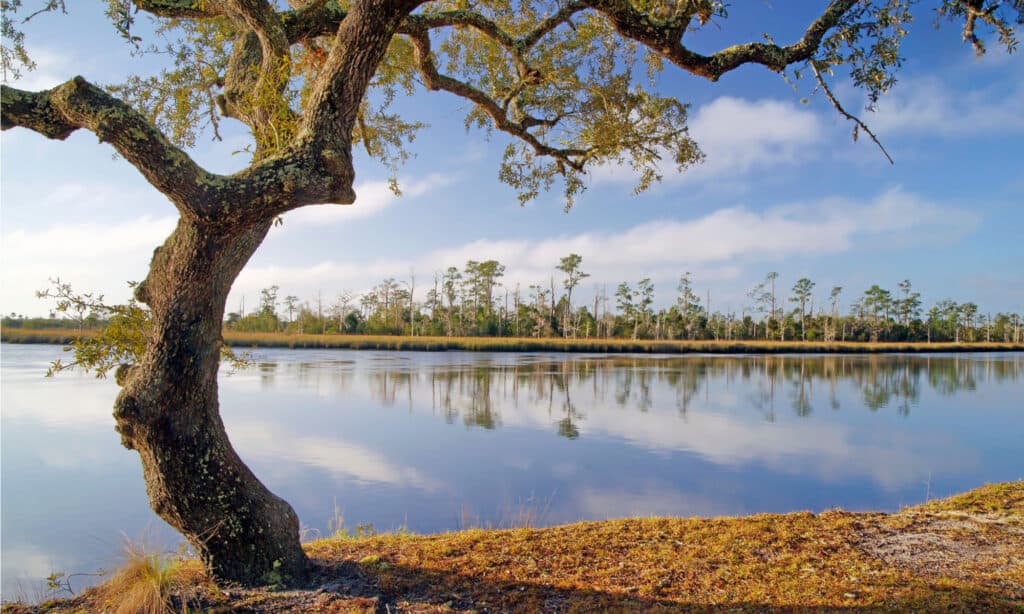
The Ochlockonee River is one of the longest rivers in Florida.
©Fsendek/Shutterstock.com
Let’s turn back the clock and dive into the past. Picture the year 1927 in the heart of Florida. That’s when the process of creating Lake Talquin started. The driving force? The construction of the Jackson Bluff Dam on the Ochlockonee River by the Talquin Electric Cooperative. The dam served a dual purpose. It not only created Lake Talquin but also produced hydroelectric power.
The Purpose Behind Lake Talquin’s Creation
The lake didn’t just happen; there was a strategic intent behind its creation. With Florida’s rapid growth, energy became a pressing need. The Jackson Bluff Dam was the answer to the area’s increasing energy demand. By harnessing the water’s power, it generated electricity for surrounding communities.
Impact on Local Communities
Lake Talquin began to shape lives around it. The communities saw not just light but opportunities too. The lake boosted local economies by providing fishing opportunities and increasing tourism. Over time, residents adapted their livelihoods around the lake, marking a new era for the region.
The Name’ Lake Talquin’
Ever wondered about the name? ‘Lake Talquin’ isn’t a random pick. It’s a clever fusion of the two cities it borders, ‘Tallahassee’ and ‘Quincy.’ The lake beautifully mirrors the blend of natural beauty and resourcefulness that the cities exhibit.
Evolution Over the Years
From an artificial creation to a natural marvel, Lake Talquin has come a long way. Over the years, it evolved into a haven for wildlife and a paradise for nature enthusiasts. Today, it is a testament to the harmonious blending of human ingenuity and nature’s bounty.
Animals of Lake Talquin
Lake Talquin is a bustling hub of life, teeming with a variety of creatures. From the smallest insects to the largest birds and mammals, the lake offers shelter and nourishment to an array of species. Let’s peek into the vibrant world of Lake Talquin’s fauna.
Aquatic Life: Residents of the Deep

A young girl holding the fish she caught, bluegill, which are common in Lake Talquin.
©iStock.com/woogies1
Lake Talquin’s clear waters are a refuge for numerous fish species. The Largemouth Bass, with its notable size and fighting spirit, is a favorite among anglers. The lake also houses Bluegill, Crappie, and Catfish, creating a diverse underwater community. But it’s not just about fish; turtles and alligators also call these waters home, adding a touch of wilderness.
Bird Species: Masters of the Sky
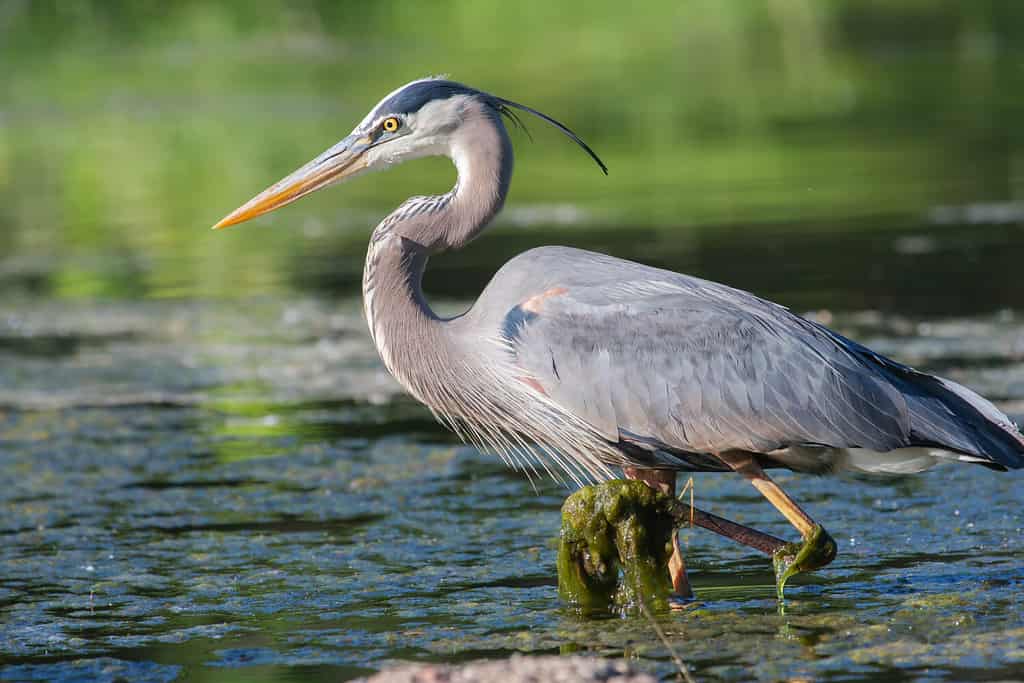
Despite their impressive size, Great Blue Herons weigh only 5 to 6 pounds thanks in part to their hollow bones—a feature all birds share.
©Joseph Scott Photography/Shutterstock.com
Look up, and you’ll witness a sky full of avian wonders. Lake Talquin serves as a pit-stop for many migratory birds. Ospreys, known for their impressive fishing skills, are a common sight. Wading birds like the Great Blue Heron and the Snowy Egret roam the shores, their graceful movements a sight to behold. Don’t be surprised to spot Bald Eagles, the symbol of national pride, nesting in the tall trees around the lake.
Mammals: Furry Inhabitants

White-tailed deer are commonly found near Lake Talquin.
©Tom Reichner/Shutterstock.com
Lake Talquin’s verdant surroundings provide the perfect backdrop for a variety of mammals. White-tailed Deer wander the forested areas, their elegant forms a treat to the eyes. Squirrels scamper about the trees, adding a playful vibe. Look out for the occasional River Otter sliding into the water with a splash!
Insects and Amphibians: The Small Wonders
Often overlooked but equally important are the lake’s smaller residents. Frogs and toads add music to the nights with their choruses. A host of insects, from dragonflies to butterflies, add to the lake’s vibrant biodiversity. They serve as essential pollinators and a crucial part of the food chain.
Flora of Lake Talquin
Lake Talquin is more than an artificial lake in Florida; it’s a thriving green sanctuary. Trees, shrubs, aquatic plants—the flora of Lake Talquin paints a captivating picture. This verdant tapestry plays an essential role in the lake’s ecosystem, providing food, shelter, and nesting sites for a plethora of creatures. Let’s explore the leafy inhabitants of this paradise.
Trees: The Tall Residents
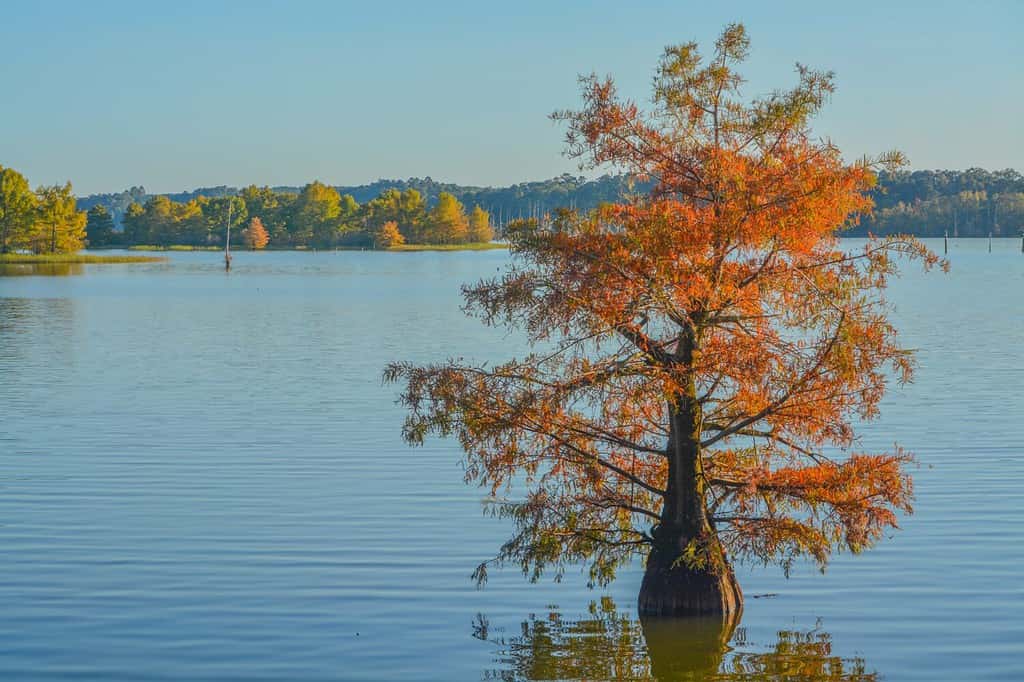
In cultivation, the Bald Cypress has a typical height between 50 and 70 feet, though it can grow much taller in the wild.
©Norm Lane/Shutterstock.com
The shoreline of Lake Talquin is lined with towering trees that offer shade and tranquility. The Bald Cypress, a local favorite, adorns the banks with its unique “knees.” These protruding roots not only lend an aesthetic appeal but also assist in oxygen intake. You’ll also find Swamp Tupelo trees, known for their high water tolerance, adding to the area’s lushness. Let’s not forget the majestic Southern Pines and Oaks, their broad canopies adding to the lake’s picturesque vistas.
Shrubs and Understory Plants: The Lower Canopy

Take a step closer to the ground, and you’ll find an array of shrubs and understory plants. The Wax Myrtle, with its aromatic leaves and small, waxy berries, is a common sight. You’ll also spot Buttonbush, known for its sphere-shaped flowers, a favorite among butterflies. Adding splashes of color are the vibrant blooms of the Swamp Azalea and the Virginia Sweetspire.
Recreation and Tourism at Lake Talquin
The charm of Lake Talquin doesn’t stop at its natural beauty. It extends into leisure and fun. A hub of recreation and a magnet for tourists, Lake Talquin, has something to offer every visitor. So, let’s dive into the exciting world of recreation and tourism at this sparkling gem.
Fishing: Hook, Line, and Sinker!

Fishing for largemouth bass is a favorite pastime of many locals of Lake Talquin.
©Pierre Rebollar/Shutterstock.com
The thrill of a tug on the fishing line is a feeling many at Lake Talquin know well. Its deep, clear waters make it a haven for anglers. With an impressive variety of fish, from Largemouth Bass to Crappie, the lake offers year-round fishing opportunities. The local fishing tournaments are a must-try, adding a dash of friendly competition to the mix!
Boating and Water Sports: Ride the Waves
Lake Talquin’s expansive waters are perfect for boating. Enjoy a leisurely boat ride, feel the wind in your hair on a speedboat, or row your way around in a canoe. Alternatively, if you’re a fan of water sports, you’re in for a treat. With areas designated for water skiing and jet skiing, Lake Talquin promises an adrenaline rush!
Hiking and Bird Watching: Into the Wild
If you’re more of a landlubber, the trails around Lake Talquin offer excellent hiking opportunities. Also, you can explore the area’s diverse flora and fauna on foot, with trails ranging from leisurely strolls to challenging hikes. And let’s not forget the bird watchers! With a plethora of bird species to spot, don’t forget to pack your binoculars.
Picnicking and Camping: A Taste of the Outdoors

Lakeside camping is very common near Lake Talquin.
©Jacob Lund/Shutterstock.com
Imagine a picnic with the beautiful Lake Talquin as your backdrop. The area’s picnic spots are perfect for a family outing. And when the sun dips down, why not stay the night? The lake’s camping sites offer a chance to experience the tranquility of nature under a starlit sky.
Lake Talquin’s Environmental Impact
Lake Talquin is more than an artificial marvel; it’s an environmental cornerstone. Its impact on the surrounding ecosystem is significant and multi-faceted. Let’s delve into the lake’s contributions to Florida’s environment.
Biodiversity Hotspot
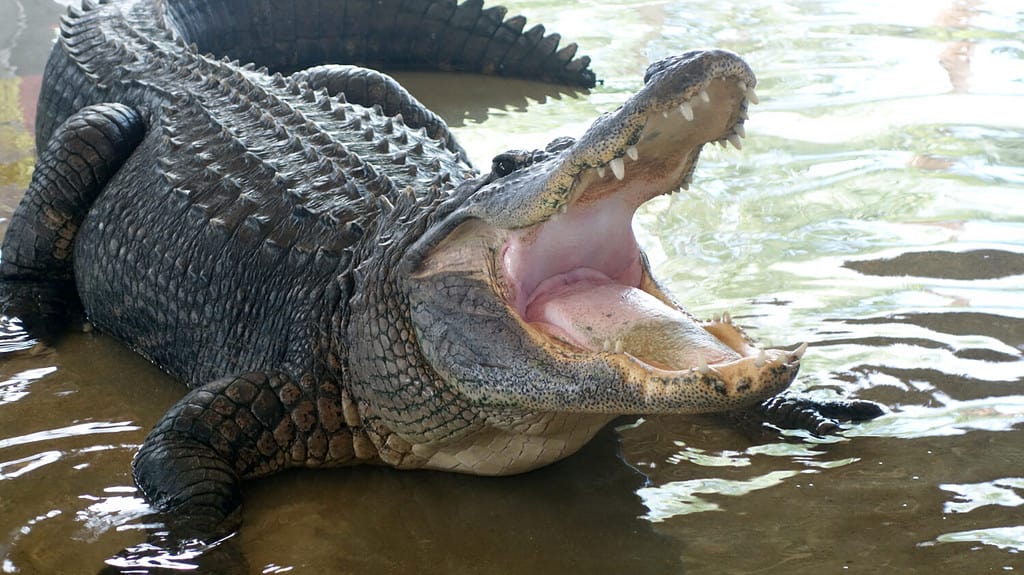
Although some of the wildlife looks scary, they all play an important role in their ecosystem.
©Ernie Hounshell/Shutterstock.com
Lake Talquin’s lush environs provide a habitat for an impressive array of flora and fauna. The lake acts as a biodiversity hotspot, nurturing numerous species and contributing to the overall health of the state’s ecosystem. It is a living, breathing sanctuary where life thrives in all its glory.
Water Management
The Jackson Bluff Dam and Lake Talquin play a pivotal role in water management. They control the flow of the Ochlockonee River, preventing flooding and ensuring a steady supply of water. This balance maintains the health of the surrounding ecosystems and supports the communities living nearby.
Air Quality
The rich vegetation around Lake Talquin acts as the region’s green lungs. Trees and plants actively take in carbon dioxide and emit oxygen, enhancing the quality of the air we breathe. They also act as natural filters, reducing pollutants and creating a healthier environment.
Recreation Meets Conservation
Lake Talquin’s recreational activities are a testament to responsible tourism. The lake offers numerous leisure activities while maintaining its ecological integrity. This balance not only promotes sustainable tourism but also educates visitors about the importance of conservation.
Climate Buffer: Nature’s Defense
Lake Talquin and its surrounding vegetation act as a natural climate buffer. The trees absorb carbon, one of the primary greenhouse gases, helping mitigate climate change. The lake itself plays a role in moderating local temperatures, creating a microclimate that benefits both wildlife and humans.
Key Takeaways
As our journey through Lake Talquin’s fascinating narrative draws to a close, it’s clear that this artificial wonder is more than just a lake. It’s a thriving ecological oasis, a historical monument, a recreational haven, an environmental guardian, and a promising vision for the future. Lake Talquin stands tall as a testament to Florida’s natural beauty and human innovation, holding its place in history while shaping a sustainable path forward. From its creation nearly a century ago, the lake continues to captivate, educate, and inspire, remaining a cherished part of Florida’s legacy.
The photo featured at the top of this post is © Patrick Jennings/Shutterstock.com
Thank you for reading! Have some feedback for us? Contact the AZ Animals editorial team.






